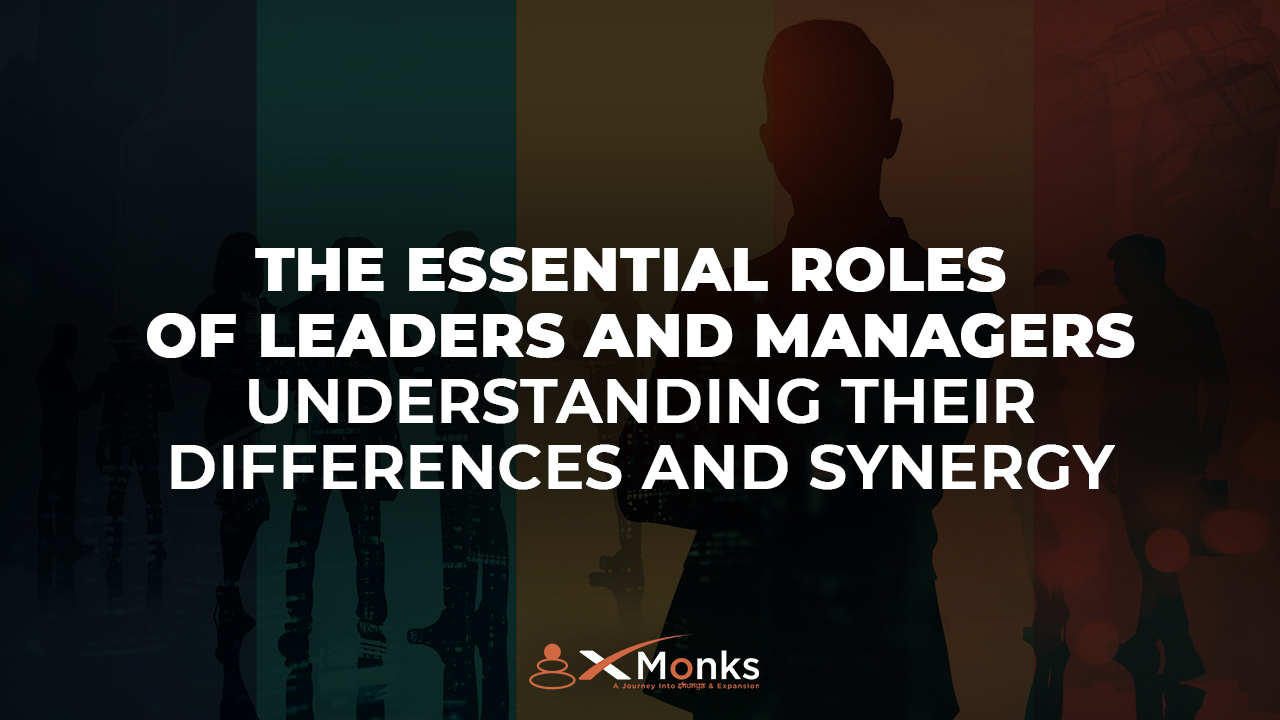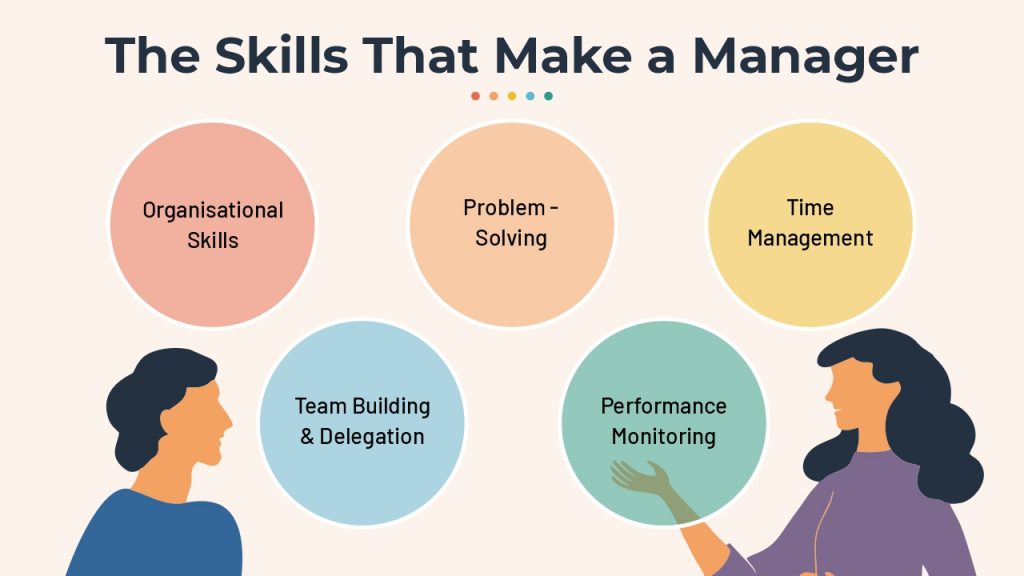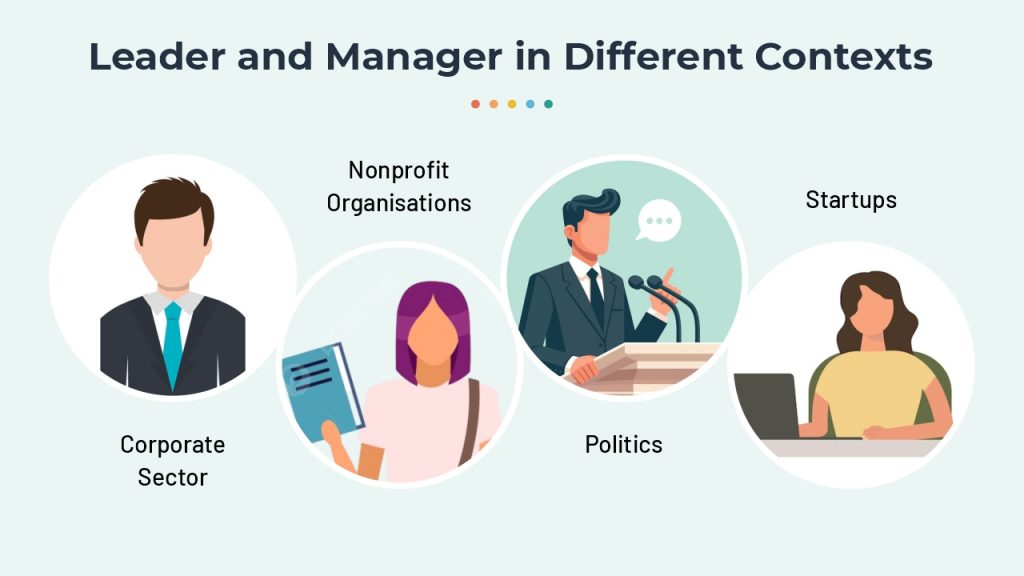Table of Contents
ToggleThe Essential Roles of Leaders and Managers: Understanding Their Differences and Synergy

In today’s rapidly evolving business landscape, the concepts of leadership and management are frequently discussed, sometimes interchangeably, and often misunderstood. Both leaders and managers play essential roles within an organisation, yet their approaches, responsibilities, and impacts can be quite distinct. This blog aims to dive into the core differences and synergies between leaders and managers, providing a comprehensive understanding of how each contributes to the success and growth of an organisation.
Defining Leadership and Management
At the core of every successful organisation is a strong leader and an efficient manager, both playing vital but distinct roles. Leadership is about vision, inspiration, and guiding people toward a future goal, whereas management focuses on execution, organisation, and administration.
A leader is typically forward-thinking, focusing on innovation and change. They inspire people through motivation, creating a shared vision that drives progress. A leader asks, What should we do next? and focuses on the bigger picture.
A manager, on the other hand, is focused on practical execution—the nuts and bolts of running an organisation. They create structures, establish processes, and ensure that the day-to-day tasks are accomplished in a timely and efficient manner. While a leader asks, “What should we do?” a manager asks, “How should we do it?” Managers are more detail-oriented, concentrating on setting clear goals, delegating tasks, and maintaining operational stability.
Though both roles differ in focus, they are equally crucial. A leader without good management will struggle to turn vision into reality, while a manager without leadership can stifle innovation and growth. This synergy between leadership and management is the key to long-term success.
The Synergy of Leaders and Managers
While leaders and managers have distinct roles, the best organisations know how to blend these two. Modern companies increasingly look for individuals who embody traits of both leadership and management, especially in senior roles. A visionary CEO, for example, needs both the boldness of a leader and the pragmatism of a manager to steer the company toward success.
Leaders who embrace management skills are more effective because they can bring their vision to life through proper planning and coordination. Similarly, managers who develop leadership qualities inspire their teams more deeply, helping them align with the organisation’s broader vision. When the two roles harmonise, it creates a powerful dynamic that propels an organisation forward.
The Skills That Make a Leader
To be an effective leader, certain core qualities are essential. These are primarily centered around emotional intelligence, creativity, and the ability to inspire others. Let’s break down some of the key skills of a modern-day leader:
- Visionary Thinking: Leaders are forward-looking. They can see beyond the present and imagine a future filled with possibilities. This forward-thinking attitude helps them inspire teams toward long-term goals.
- Emotional Intelligence: Understanding emotions—both their own and others’—helps leaders navigate the complexities of human relationships. Emotional intelligence enables leaders to inspire trust, loyalty, and enthusiasm in their teams.
- Resilience: In times of crisis or uncertainty, leaders are the ones who must remain calm and composed. The ability to handle stress and maintain a positive outlook is a critical leadership trait.
- Creativity and Innovation: Leaders must constantly think outside the box and look for innovative solutions. Their willingness to embrace change is what often leads organisations into new territory.
- Effective Communication: One of the most important roles of a leader is to communicate a vision clearly. Leaders must be able to inspire action through their words, whether speaking one-on-one or addressing an entire organisation.
The Skills That Make a Manager

Managers, on the other hand, require a different set of skills, more rooted in structure, logic, and practicality. Their role is essential for ensuring that the leader’s vision can be executed properly. Some of the critical skills for managers include:
- Organisational Skills: Good managers are adept at setting up efficient systems and processes to meet goals. They understand how to allocate resources, manage time, and keep things running smoothly.
- Problem-Solving: Managers are the problem solvers of an organisation. Whether it’s a logistical issue or a team-related conflict, managers must find the most effective and efficient solution.
- Time Management: Deadlines are crucial for any organisation, and it is the manager’s job to ensure that projects are delivered on time. The ability to prioritise tasks and delegate responsibilities is vital.
- Team Building and Delegation: A manager knows how to build a cohesive team and assign roles effectively. They recognise the strengths of their team members and delegate tasks accordingly.
- Performance Monitoring: Managers must ensure that teams are meeting their objectives. This involves setting measurable goals, tracking progress, and providing constructive feedback.
The Balance Between Leadership and Management
In today’s complex workplace environment, organisations benefit greatly when individuals in leadership roles are also proficient in management, and vice versa. A balance between leadership and management allows for not only the creation of a vision but the effective execution of that vision through careful planning and coordination.
In fact, some of the most successful executives seamlessly shift between leading and managing as required. They inspire their teams to think big while ensuring that day-to-day operations align with long-term goals. This combination creates a dynamic and adaptable organisation that is prepared to thrive in a rapidly changing world.
Leader and Manager in Different Contexts

It’s important to note that the dynamics between leaders and managers can differ across various industries and sectors. Here’s a brief look at how these roles function in different settings:
- Corporate Sector: In the corporate world, the CEO often serves as the organisation’s primary leader, while senior managers and department heads focus on operational management. Here, the distinction between leadership and management is most evident, with leaders responsible for steering the company toward new opportunities, and managers ensuring that teams are efficient and productive.
- Nonprofit Organisations: In nonprofits, the leader often has a deep personal connection to the cause, inspiring others to contribute toward social good. Managers, on the other hand, focus on fundraising, volunteer coordination, and logistical operations.
- Politics: In politics, leaders like heads of state set the strategic direction of a country, making key decisions on policy and reform. Their managers—staff, aides, and bureaucratic officials—ensure the smooth execution of those policies.
- Startups: In startup environments, founders often wear both hats, serving as visionary leaders who inspire investors and employees alike, while also taking on managerial tasks such as budgeting, operations, and human resources.
Leadership ‘Past’ and ‘Present’
Leadership has evolved dramatically over the past few decades. Earlier leadership models were largely based on hierarchical structures, top-down decision-making, and command-and-control approaches. In contrast, present-day leadership has shifted toward more inclusive, flexible, and people-centric models that emphasise collaboration, adaptability, and emotional intelligence. This essay explores the key differences between traditional leadership models of the past and the contemporary leadership styles of today.
Top-Down vs. Collaborative Leadership
Earlier Leadership: Traditional leadership was heavily rooted in authority, with power concentrated at the top. Leaders were expected to make decisions independently, and employees were often required to follow instructions without much room for input. This command-and-control style was particularly prevalent in industries like manufacturing, military, and large bureaucratic organisations. The leader was seen as the sole source of direction, with employees expected to execute tasks without questioning.
Present-Day Leadership: Modern leadership embraces collaboration. Rather than relying on a top-down approach, contemporary leaders encourage input from team members and foster an environment where collective decision-making is valued. The emphasis is on empowering employees, leveraging diverse perspectives, and creating a culture of inclusion. Leaders are now facilitators, guiding teams to achieve common goals rather than dictating actions. The shift towards flatter organisational structures, particularly in tech-driven companies, reflects this more democratic style of leadership.
Emphasis on Results vs. Emphasis on People
Earlier Leadership: Traditionally, leadership was very result-oriented. Leaders were measured primarily by their ability to meet financial targets, increase productivity, and ensure efficiency. Relationships and emotional factors were often overlooked, with the focus squarely on the bottom line. This leadership style was more transactional, with leaders offering rewards or consequences based on employee performance.
Present-Day Leadership: Today’s leadership models put a greater emphasis on people, not just performance. Employee well-being, job satisfaction, and emotional engagement are considered essential components of leadership success. Contemporary leaders are expected to balance achieving business goals with fostering a healthy work environment. Emotional intelligence has become a core competency for leaders, as it allows them to better understand and respond to the needs of their teams. The shift from transactional leadership to transformational leadership reflects this broader focus on human-centred leadership.
Stability vs. Adaptability
Earlier Leadership: Stability and consistency were the hallmarks of traditional leadership. Leaders were expected to maintain order, minimise risks, and ensure that processes were followed meticulously. This approach worked well in industries where predictability and standardisation were essential for success, such as manufacturing or government institutions.
Present-Day Leadership: In contrast, today’s leaders must be highly adaptable. The fast pace of technological advancements, changing consumer demands, and global market shifts require leaders to be flexible and open to change. Agile leadership, which focuses on adaptability, responsiveness, and innovation, has become critical in today’s dynamic work environment. Leaders are expected to guide their teams through uncertainty, embrace change, and encourage creativity to stay competitive.
Directive vs. Coaching Leadership
Earlier Leadership: In the past, leaders were expected to direct, instruct, and control their teams. There was less emphasis on individual development, with employees seen as cogs in a machine rather than unique contributors. The leader’s role was primarily to assign tasks and ensure compliance with established protocols.
Present-Day Leadership: Today’s leaders often adopt a coaching mentality, focusing on the personal and professional growth of their team members. Leaders are now seen as mentors who help individuals develop their skills, build confidence, and realize their potential. This approach aligns with the growing recognition that employee development and engagement are key drivers of long-term organisational success. The leader as a coach helps cultivate a growth mindset and promotes continuous learning within the team.
Focus on Authority vs. Emotional Intelligence
Earlier Leadership: Authority and control were central to traditional leadership models. The leader was often seen as a figure of authority whose power was unquestionable. Decision-making was centralized, and emotional considerations were rarely taken into account. Leaders were more focused on asserting their position than understanding the emotional dynamics within their teams.
Present-Day Leadership: Emotional intelligence (EQ) is now recognised as one of the most important qualities in modern leadership. Present-day leaders are expected to be empathetic, self-aware, and able to manage their emotions effectively. This shift reflects the growing understanding that emotional intelligence is linked to better team dynamics, improved employee engagement, and stronger organisational performance. Leaders who demonstrate high EQ are better equipped to build trust, foster collaboration, and resolve conflicts.
Hierarchical Structures vs. Flat Organisations
Earlier Leadership: Traditional leadership models operated within rigid hierarchical structures. Leaders were positioned at the top, and the flow of information was linear, with directives passed down through multiple layers of management. Hierarchies were clearly defined, and there was little room for employees to challenge authority or propose new ideas.
Present-Day Leadership: Flat organisational structures have become more common in contemporary leadership models. In these structures, the chain of command is less rigid, and employees at all levels are encouraged to contribute to decision-making processes. This approach promotes transparency, fosters innovation, and allows for faster decision-making. Leaders in flat organisations focus on empowering their teams and facilitating collaboration across departments.
Leadership for Profit vs. Leadership for Purpose
Earlier Leadership: In the past, leadership was primarily driven by financial metrics. Success was defined by profitability, and leaders were measured by their ability to increase shareholder value. Social and environmental considerations were often secondary to economic goals.
Present-Day Leadership: Today’s leaders are increasingly focused on purpose-driven leadership. Modern leaders recognise that organisations must serve a broader purpose beyond profit. This includes addressing social, environmental, and ethical considerations. Leaders are now expected to incorporate corporate social responsibility (CSR) into their strategies, balancing profit with a positive impact on society and the planet.
The evolution of leadership reflects broader societal changes, including a shift toward more inclusive, flexible, and emotionally intelligent practices. While earlier leadership models prioritised authority, results, and stability, present-day leadership focuses on collaboration, adaptability, and the well-being of employees. By embracing emotional intelligence, fostering inclusive cultures, and prioritising purpose over profit, modern leaders are better equipped to navigate the complexities of today’s business environment. As leadership continues to evolve, the emphasis on human-centered approaches will likely grow, creating more agile and compassionate leaders who can inspire their teams to thrive in an ever-changing world.
Challenges in Leadership and Management
While the synergy between leadership and management is crucial, both roles come with their own unique challenges. Leaders often face the difficulty of pushing for change in environments resistant to new ideas. The emotional burden of leadership, which involves inspiring others and making tough decisions, can lead to burnout.
Managers, on the other hand, face the challenge of balancing multiple priorities, ensuring efficiency without stifling creativity, and managing conflicts within the team. They must juggle short-term operational goals with long-term strategic initiatives, which can create friction if not properly aligned with leadership.
Leadership and Communication
One area where both leaders and managers overlap significantly is in the realm of communication. Both roles require clear, consistent, and compelling communication to ensure that everyone within the organisation is aligned toward common goals. Leaders use communication to inspire and motivate, while managers use it to delegate and clarify.
Leaders and communication are intrinsically linked. A good leader can craft a vision, but it’s the ability to communicate that vision effectively that turns it into reality. Leaders who are excellent communicators can inspire change, influence stakeholders, and build strong relationships both inside and outside the organisation.
For managers, communication is just as vital. Effective communication ensures that team members understand their tasks, deadlines are met, and expectations are clear. Managers who fail to communicate properly can create confusion, lower morale, and hinder productivity.
The Future of Leadership and Management
As we move further into the 21st century, the roles of leaders and managers will continue to evolve. The rise of remote work, AI integration, and a greater emphasis on work-life balance are transforming how organisations are led and managed.
- Digital Leadership: Future leaders will need to embrace digital transformation, understanding how to integrate new technologies into their vision for the future. Digital literacy will become an essential trait of both leaders and managers.
- Inclusive Leadership: There is a growing focus on diversity and inclusion within organisations. Future leaders will need to ensure that their leadership styles foster inclusivity, promote diverse perspectives, and create a culture where everyone feels heard.
- Sustainability Leadership: Leaders will increasingly need to integrate sustainability into their strategies. Managers will need to adapt by creating processes that support these initiatives, from reducing carbon footprints to adopting eco-friendly business practices.
FAQs
Conclusion
In summary, while leaders and managers have distinct roles within an organisation, the two are deeply interconnected. Leaders provide vision and direction, while managers ensure that the day-to-day operations align with those long-term goals. In an ideal organisation, the two roles work in tandem to drive innovation, efficiency, and success.
As the business world continues to evolve, the need for both strong leadership and effective management will only become more critical. By cultivating skills in both areas, individuals and organisations can thrive, staying adaptable and resilient in a rapidly changing landscape.

